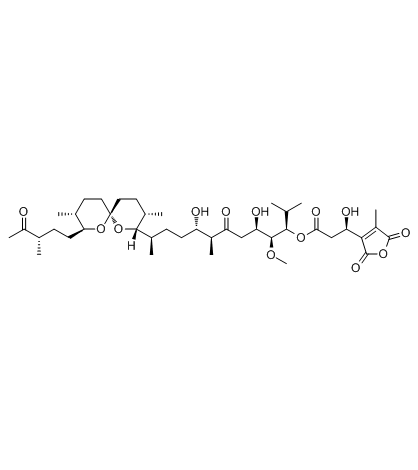Tautomycin

Tautomycin structure
|
Common Name | Tautomycin | ||
|---|---|---|---|---|
| CAS Number | 109946-35-2 | Molecular Weight | 766.95500 | |
| Density | 1.18g/cm3 | Boiling Point | 854.3ºC at 760mmHg | |
| Molecular Formula | C41H66O13 | Melting Point | N/A | |
| MSDS | Chinese USA | Flash Point | 247.5ºC | |
| Symbol |

GHS06 |
Signal Word | Danger | |
|
Characterization of the tautomycetin biosynthetic gene cluster from Streptomyces griseochromogenes provides new insight into dialkylmaleic anhydride biosynthesis.
J. Nat. Prod. 72(3) , 450-9, (2009) Tautomycetin (TTN) is a highly potent and specific protein phosphatase inhibitor isolated from Streptomyces griseochromogenes. The biological activity of TTN makes it an important lead for drug discovery, whereas its rare dialkylmaleic anhydride moiety and st... |
|
|
The bifunctional glyceryl transferase/phosphatase OzmB belonging to the HAD superfamily that diverts 1,3-bisphosphoglycerate into polyketide biosynthesis.
J. Am. Chem. Soc. 128(32) , 10386-7, (2006) The HAD superfamily protein OzmB from the oxazolomycin biosynthetic pathway is shown to divert the primary metabolite 1,3-diphosphoglycerate into the polyketide biosynthetic pathway as glycerate via loading of a carrier protein. Each of the steps-activation o... |
|
|
PR55 alpha, a regulatory subunit of PP2A, specifically regulates PP2A-mediated beta-catenin dephosphorylation.
J. Biol. Chem. 284 , 22649 - 22656, (2009) A central question in Wnt signaling is the regulation of beta-catenin phosphorylation and degradation. Multiple kinases, including CKI alpha and GSK3, are involved in beta-catenin phosphorylation. Protein phosphatases such as PP2A and PP1 have been implicated... |
|
|
Tautomycin suppresses growth and neuroendocrine hormone markers in carcinoid cells through activation of the Raf-1 pathway
Am. J. Surg. 197(3) , 313-9, (2009) Background Carcinoids are neuroendocrine (NE) tumors with limited treatment options. Raf-1 pathway activation has been shown to suppress hormone production in carcinoid cells. We investigated a novel treatment for carcinoid cell growth based on pharmacologic ... |
|
|
Tautomycin's interactions with protein phosphatase 1.
Chem. Asian J. 5(3) , 410-20, (2010) It has been a long journey since tautomycin (TTM) was isolated in 1987 and the discovery that it inhibited protein phosphatase 1 (PP1) more strongly than PP2A until finally the cocrystal structure of TTM and PP1 was presented early in 2009. The fact that TTM ... |
|
|
Functional characterization of ttmM unveils new tautomycin analogs and insight into tautomycin biosynthesis and activity.
Org. Lett. 11(7) , 1639-42, (2009) The biosynthetic gene cluster for tautomycin (TTM), a potent protein phosphatase (PP) inhibitor has recently been characterized. Inactivation of ttmM, which encodes a putative C3' hydroxylase, afforded mutant SB6005 which accumulated three new 3'-deshydroxy T... |
|
|
Synthesis of [18,19,21,22-(13)C4]-labeled tautomycin as an NMR probe of protein phosphatase inhibitor.
Chem. Asian J. 2(3) , 377-85, (2007) We have accomplished the synthesis of 13C-labeled tautomycin at the C18, C19, C21, and C22 positions starting from 100% [13C]triethylphosphonoacetate for the purpose of elucidating the dynamics and conformation of the C17-C26 moiety. NMR spectroscopy of 13C-l... |
|
|
Protein phosphatase 1-dependent dephosphorylation of Akt is the prime signaling event in sphingosine-induced apoptosis in Jurkat cells.
J. Cell. Biochem. 112(4) , 1138-53, (2011) Sphingosine (SPH) is an important bioactive lipid involved in mediating a variety of cell functions including apoptosis. However, the signaling mechanism of SPH-induced apoptosis remains unclear. We have investigated whether SPH inhibits survival signaling in... |
|
|
Cell adhesion regulates Ser/Thr phosphorylation and proteasomal degradation of HEF1.
J. Cell Sci. 119(Pt 1) , 96-103, (2006) Human enhancer of filamentation 1 (HEF1), a multifunctional docking protein of the Cas family, participates in integrin and growth factor signaling pathways that regulate global cellular processes including growth, motility and apoptosis. HEF1 consists of two... |
|
|
Apparent PKA activity responds to intermittent hypoxia in bone cells: a redox pathway?
Am. J. Physiol. Heart Circ. Physiol. 299 , 225-35, (2010) We studied hypoxia-induced dynamic changes in the balance between PKA and PKA-counteracting phosphatases in the microfluidic environment in single cells using picosecond fluorescence spectroscopy and intramolecular fluorescence resonance energy transfer (FRET... |